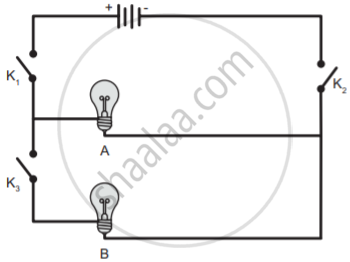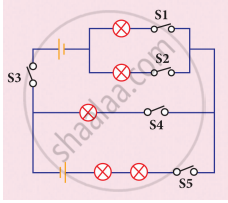Advertisements
Advertisements
प्रश्न
Explain the construction and working of the following. Draw a neat diagram and label it.
Electric motor
Explain the construction and working of electric motor in short.
उत्तर
- Construction: Electric motor consists of the following parts:
- Rectangular coil: A large number of turns of insulated copper wire wound on iron core in rectangular shape forms a coil ABCD as shown in following figure.
- Strong magnet: The coil is placed in between two pole pieces (N and S) of a strong horse shoe magnet which provides a strong magnetic field. The sides AB and CD are perpendicular to the direction of the magnetic field.
- Split ring: It consists of two halves of a metallic ring (X and Y). The ends of the coil are connected to these rings. The outer conducting surfaces of spilt rings X and Y are in contact with the two stationary carbon brushes. Spilt rings reverse the direction of current in the coil.
- Brushes: Two carbon brushes E and F are used to press the split rings.
- Axle: The two halves of the rings have a resistive coating in their inner surfaces and are tightly fitted on the axle. The main function of an axle is to rotate with the coil.
- Battery: The battery supplies the current to the coil.

- Working:
- When the circuit is completed, the current passes through the brush E from A to B in branch AB.
- As, the magnetic field acts from north pole to south pole, according to Fleming’s left-hand rule, the force experienced by arm AB is in the downward direction and arm CD is in the upward direction.
- Both these forces are equal in magnitude and opposite in direction and hence, the coil rotates in an anticlockwise direction.
- After half rotation, the split rings X and Y come in contact with brushes E and F respectively.
- Again the current starts passing through the coil in opposite direction.
- The force acting on branch BA is upward and DC is downward, this force again moves the coil in an anticlockwise direction.
- This shows that the current in the loop ABCD is reversed after every half rotation, and the loop continues to rotate in the same direction.
- Thus, the coil rotates with the help of electrical energy.
APPEARS IN
संबंधित प्रश्न
Redraw the circuit of question 1, putting in an ammeter to measure the current through the resistors and a voltmeter to measure the potential difference across the 12 Ω resistors. What would be the readings in the ammeter and the voltmeter?
What do the following symbols mean in circuit diagrams?

Draw circuit symbols for
fixed resistance
Draw circuit symbols for variable resistance
Draw circuit symbols for
a cell
The following figure shows the symbols for components used in the accompanying electrical circuit. Place them at proper places and complete the circuit.

Which law can you prove with the help of above circuit?
In an electric circuit, electron flow a from of point of ______ potential to the point of ______ potential.
In an electric circuit, a battery and a bulb have been connected and the battery consists of two cells of equal potential difference. If the bulb is not glowing, then which tests will you perform in order to find out the reason for the bulb not glowing?
Write the condition required for a circuit to be a closed circuit.
Answer the following question.
With the help of a suitable circuit diagram prove that the reciprocal of the equivalent resistance of a group of resistances joined in parallel is equal to the sum of the reciprocals of the individual resistances.
Draw a neat diagram showing a open electric circuit.
What is the potential difference?
Increasing the current passing through the wire decreases the magnetic field intensity.
Write scientific reason.
It is beneficial to carry electrical energy in AC form as it is carried over long distances.
______ is the device used to close or open an electric circuit.
In the given circuit diagram, which of the given switch(s) should be closed. So that only bulb A glows.

Draw the circuit diagram for the series connection.
Rahul wants to make an electric circuit. He has a bulb, two wires, a safety pin, and a piece of copper. He does not have any electric cell or battery. Suddenly he gets some idea. He uses lemon instead of a battery and makes a circuit. Will the bulb glow?
In which among the following circuits does the bulb glow?
In the circuit shown, which switches (L,M or N) must be closed to light up the bulb?

Study the electric circuit below. Which of the following switches should be closed so that only two bulbs will light up

What is electric circuit?
State whether true or false. If false, correct the statement.
Ammeter is connected in parallel in any electric circuit.
In a circuit, if the key is in open (off) condition, then electricity will not flow.
What are the types of electric circuits?
In an electrical circuit three incandescent bulbs A, B and C of rating 40 W, 60 W and 100 W respectively are connected in parallel to an electric source. Which of the following is likely to happen regarding their brightness?
In an electrical circuit two resistors of 2 Ω and 4 Ω respectively are connected in series to a 6 V battery. The heat dissipated by the 4 Ω resistor in 5 s will be
Draw a circuit diagram of an electric circuit containing a cell, a key, an ammeter, a resistor of 2Ω in series with a combination of two resistors (4Ω each) in parallel and a voltmeter across the parallel combination. Will the potential difference across the 2Ω resistor be the same as that across the parallel combination of 4Ω resistors? Give reason.
Observe the circuit given:
1. Would any of the bulbs glow when the switch is in the ‘OFF’ position?

2. What will be the order in which the bulbs A, B, and C will glow when the switch is moved to the ‘ON’ position?

In the above circuit, if the current reading in the ammeter A is 2A, what would be the value of R1?
Write a short note on the different electrical circuits.
How is Joule's law effect useful in electric circuits where fuse is used as a safety device?
